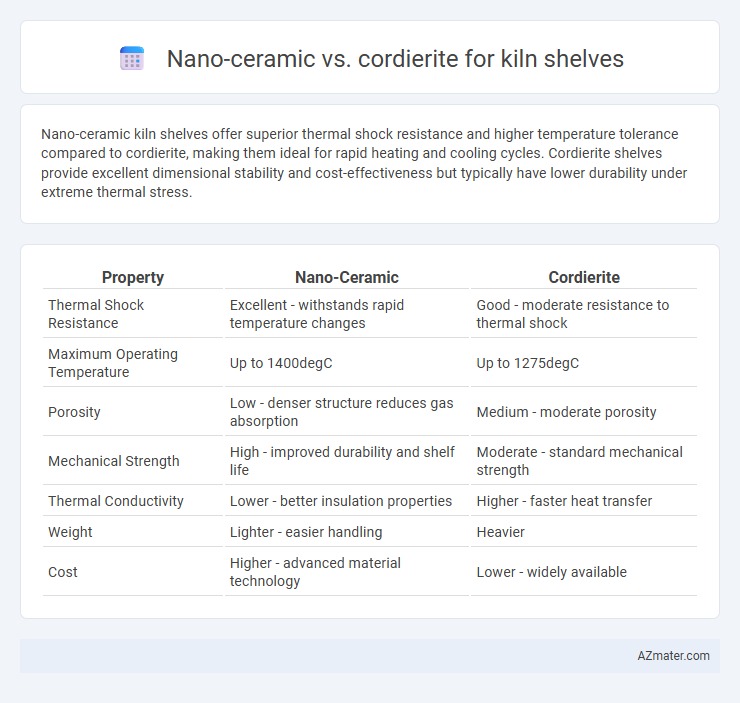Nano-ceramic kiln shelves offer superior thermal shock resistance and higher temperature tolerance compared to cordierite, making them ideal for rapid heating and cooling cycles. Cordierite shelves provide excellent dimensional stability and cost-effectiveness but typically have lower durability under extreme thermal stress.
Table of Comparison
| Property | Nano-Ceramic | Cordierite |
|---|---|---|
| Thermal Shock Resistance | Excellent - withstands rapid temperature changes | Good - moderate resistance to thermal shock |
| Maximum Operating Temperature | Up to 1400degC | Up to 1275degC |
| Porosity | Low - denser structure reduces gas absorption | Medium - moderate porosity |
| Mechanical Strength | High - improved durability and shelf life | Moderate - standard mechanical strength |
| Thermal Conductivity | Lower - better insulation properties | Higher - faster heat transfer |
| Weight | Lighter - easier handling | Heavier |
| Cost | Higher - advanced material technology | Lower - widely available |
Introduction to Kiln Shelf Materials
Nano-ceramic kiln shelves offer superior thermal shock resistance and a smoother surface compared to traditional materials, enhancing kiln longevity and product quality. Cordierite, a widely used material for kiln shelves, is prized for its excellent thermal stability and low thermal expansion, making it highly resistant to cracking during rapid temperature changes. Choosing between nano-ceramic and cordierite depends on firing temperature range, durability requirements, and budget constraints, with nano-ceramic often favored for advanced performance in high-temperature ceramic firing.
What is Nano-Ceramic for Kiln Shelves?
Nano-ceramic kiln shelves feature a microstructure enhanced by nanoparticles, providing superior thermal shock resistance and increased durability compared to traditional materials. This advanced composition minimizes warping and crack formation during rapid temperature changes in ceramic firing processes. Cordierite, while popular for its low thermal expansion, lacks the nano-engineered surface that delivers enhanced lifespan and strength found in nano-ceramic shelves.
Overview of Cordierite Kiln Shelves
Cordierite kiln shelves are widely favored for their exceptional thermal shock resistance and durability in high-temperature ceramic firing, typically up to 1260degC (2300degF). This material's low thermal expansion minimizes warping and cracking, ensuring a stable and long-lasting surface for various firing processes. Compared to nano-ceramic shelves, cordierite offers superior cost-effectiveness and mechanical strength, making it a preferred choice for many pottery and ceramics artists.
Thermal Performance: Nano-Ceramic vs Cordierite
Nano-ceramic kiln shelves exhibit superior thermal shock resistance compared to cordierite, ensuring durability under rapid temperature changes during firing cycles. Cordierite offers excellent thermal stability and low thermal expansion but is more prone to cracking under sudden temperature fluctuations. The enhanced heat tolerance of nano-ceramic materials results in longer shelf lifespan and reduced maintenance costs in high-temperature kiln environments.
Weight and Handling Differences
Nano-ceramic kiln shelves are significantly lighter than cordierite shelves, enhancing ease of handling and installation in ceramic studios and industrial settings. Cordierite shelves, known for their durability and thermal shock resistance, tend to be heavier, which can make them more cumbersome during setup and adjustment. The reduced weight of nano-ceramic shelves improves maneuverability, reducing strain on artisans and enabling more efficient kiln loading processes.
Resistance to Thermal Shock and Warping
Nano-ceramic kiln shelves exhibit superior resistance to thermal shock and warping due to their dense microstructure and enhanced thermal stability, allowing rapid temperature changes without cracking. Cordierite shelves, while known for good thermal shock resistance, are more prone to warping under prolonged high-temperature cycles compared to nano-ceramic materials. The nano-ceramic composition's ability to maintain dimensional stability under thermal stress makes it a preferred choice for high-performance kiln shelves in demanding firing conditions.
Surface Durability and Glaze Interaction
Nano-ceramic kiln shelves offer superior surface durability due to their enhanced resistance to thermal shock and abrasion compared to cordierite shelves. The nano-ceramic surface minimizes glaze adherence and prevents sticking, promoting easy clean-up and longer shelf lifespan. Cordierite, while heat-resistant, tends to be more porous, increasing the risk of glaze interaction and requiring regular maintenance to avoid damage.
Cost Comparison: Nano-Ceramic vs Cordierite
Nano-ceramic kiln shelves typically cost more upfront compared to cordierite due to advanced material properties and manufacturing processes that enhance durability and thermal shock resistance. Cordierite shelves offer a more budget-friendly option with acceptable performance, making them suitable for standard firing conditions. Evaluating long-term costs, nano-ceramic shelves may reduce replacement frequency and downtime, potentially offsetting the higher initial investment.
Longevity and Maintenance Requirements
Nano-ceramic kiln shelves offer superior longevity due to their enhanced resistance to thermal shock and glaze adhesion, reducing the frequency of replacements. Cordierite kiln shelves, while offering good thermal stability and moderate durability, typically require more maintenance to prevent cracks and glaze damage over time. Maintaining nano-ceramic shelves involves less frequent cleaning and fewer repairs, making them more cost-effective in high-use ceramic firing environments.
Choosing the Right Kiln Shelf for Your Studio
Nano-ceramic kiln shelves offer superior thermal shock resistance and minimal warping, making them ideal for studios requiring consistent performance under rapid temperature changes. Cordierite shelves are valued for their durability and lower cost, though they may absorb moisture and require careful handling to prevent cracking. Selecting the right kiln shelf depends on the specific firing temperatures, frequency of use, and budget constraints in your studio environment.

Infographic: Nano-ceramic vs Cordierite for Kiln shelf
 azmater.com
azmater.com